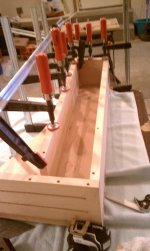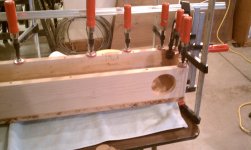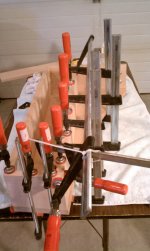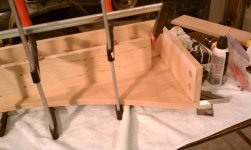I will be starting my second set of Frugel Horn speakers. I built my first ones from ply wood, this time I will be using solid clear cherry wood. This time I will take lots of pictures of the progress and post them on here. I have already bought the lumber and already own the CHP70 for this build. For anyone who has done this with solid wood, have any advise for dampening. Right now I am going to stay with the same dampening I used in my first set, which was what the build plans had. Any advise on this build would be appreciated.
Solid wood - no matter the species - is not a good idea for 6-sided tight-joint boxes, particularly folded horns with the miriad of internal baffles and channels. Either the joints or the material will fail due to expansion and contraction from changes in humidity and the finish, no matter what it is, cannot stop it. This is one of the very first lessons one learns when becoming a woodworker.
Plywood, because of the thin cross-grained laminations does not shrink or expand nearly as much as solid wood. Particle board or MDF that's sealed doesn't either (unsealed, its actually much worse). Thats why most speakers are veneered ply or sealed MDF.
If the thought of learning to do veneer work is too intimidating, just do them out of good birch ply and finish with a good poly finish. IMHO, a good sounding set of fair looking speakers, is a far sight better than a beautiful pair that's going to crack, check or break in a year or two. It's also just a waste of expensive wood.
You are not the first to try it, nor will you be the last. Just a word to the wise from a woodworker with 30+ years of experience.
Bill
Plywood, because of the thin cross-grained laminations does not shrink or expand nearly as much as solid wood. Particle board or MDF that's sealed doesn't either (unsealed, its actually much worse). Thats why most speakers are veneered ply or sealed MDF.
If the thought of learning to do veneer work is too intimidating, just do them out of good birch ply and finish with a good poly finish. IMHO, a good sounding set of fair looking speakers, is a far sight better than a beautiful pair that's going to crack, check or break in a year or two. It's also just a waste of expensive wood.
You are not the first to try it, nor will you be the last. Just a word to the wise from a woodworker with 30+ years of experience.
Bill
Got to agree with Bill here, I don't think it's completely impossible but the likelyhood of failure is very high, how about making them out of ply or MDF and lining the outside with solid cherry say 10mm thick? It's why no one makes even the most expensive kitchens out of solid wood and solid doors have a floating panel to allow for the inevitable movement, and a proportion of them still fail.
I fully agree that is a high chance of failure, especially if it is not sealed, glued or jointed properly. I just really like solid wood and love working with. The one thing of going for me is I live in Montana where humidity changes are not a huge problem. Stay nice and dry here. The wood was purchased from a small local company that mills and kiln dries there wood in Montana (expect for exotics). So I am not bring in wood that is from a humid area. I will be sealing the the inside of the box, then using dowels and glue to join everything. The outside will also be sealed as well. I have been building furniture, as a hobby, for 15 with my dad and last 5 years I have been building a lot by myself. I fully understand the risk of their being failures. Its going to be fun, because I am going to be putting my wood working stills to the test.
I think you can pull it off.
Couple tips ... maybe you know 'em.
Boards used in a wide panel must be edged slightly concave in the length. When you place them flat, like you'd glue them together, the ends should touch and there should be a space in the center. (1/32" or more) End grain gives up moisture first ... this technique puts the panel into "pre-stress". As the ends give it up, the panel starts to relax. Joints won't check if you've allowed enough at glue-up.
Areas of greatest concern will be:
The side panel bottoms ... so I'd rough cut the shape before glue up and make sure you have the edge spacing machined here in those shorter length pieces.
The top where it meets the side panel. This must float or it'll check here. Top will be joined to baffle and back so no worries about it coming off. I'd use a rabbit/dado combination for the side/top joint (no glue!) Allow for the side to move toward the back under the top piece.
The back will have to have a dado/rabbit joint along its length as well. I'd make the rabbit/dado snug for about 1/2 the length up but the upper half should have a wider dado than rabbit so the side piece can move back and forth without stressing this joint and therefore, the side. Idea is not to trap anything in at least one direction.
Cherry is getting rare and expensive .... don't choke.
Couple tips ... maybe you know 'em.
Boards used in a wide panel must be edged slightly concave in the length. When you place them flat, like you'd glue them together, the ends should touch and there should be a space in the center. (1/32" or more) End grain gives up moisture first ... this technique puts the panel into "pre-stress". As the ends give it up, the panel starts to relax. Joints won't check if you've allowed enough at glue-up.
Areas of greatest concern will be:
The side panel bottoms ... so I'd rough cut the shape before glue up and make sure you have the edge spacing machined here in those shorter length pieces.
The top where it meets the side panel. This must float or it'll check here. Top will be joined to baffle and back so no worries about it coming off. I'd use a rabbit/dado combination for the side/top joint (no glue!) Allow for the side to move toward the back under the top piece.
The back will have to have a dado/rabbit joint along its length as well. I'd make the rabbit/dado snug for about 1/2 the length up but the upper half should have a wider dado than rabbit so the side piece can move back and forth without stressing this joint and therefore, the side. Idea is not to trap anything in at least one direction.
Cherry is getting rare and expensive .... don't choke.
you could build the boxes with solid sides top and bottom with the grain running the same direction all the way around. Wood expands across the grain, not in the long direction. The box will grow from front to back. Then make the front baffle, internal dividers and back from plywood. Seems like this eliminates grain conflicts.
I currently do have a pair of demo speakers I made from ply wood and thinking about putting a veneer on them, but I am going to be building a full speaker out of solid cherry. I do agree that it's going to be a challenge. I have noticed that cherry has slowly gone up in price. The top of the speaker I do agree could cause some checking and also the front, the front I will be doubling it up so their will be one piece the covers the full front. I might do the same for the top to help with the checking. The side panel with the concave panels is a good idea. I will be sealing the inside, but this is clear cherry so they are no voids, only one piece of lumber has a small knot, but I will be cutting it out.
Here are some pics of the speaker.
what're the holes one vertical panels and slots on bottom for? and you really need to bevel the rear side of driver cut out
if you think cherry has got expensive - look at black walnut

Sapele is pretty decent right now, here at least
other than that - congrats on taking on a construction in all solid
what're the holes one vertical panels and slots on bottom for? and you really need to bevel the rear side of driver cut out
if you think cherry has got expensive - look at black walnut
Sapele is pretty decent right now, here at least
other than that - congrats on taking on a construction in all solid
Yes, look at Black Walnut...in my back yard.. I planted 10 acres when my children were born so that they had money for retirement and to buy a house... Not as good as Apple stock or IPO Facebook... but they are pretty...
JP WIsconsin
My terminals will be place there, they will be on a nice piece small piece of wenge wood. I made those holes one inch so I have room to work when I connect the terminals with the speaker wire on the bottom. There is a trough routed out on the bottom to hide the speaker wires. Making it from solid takes a lot more time, but I like working with it. I am hoping to get both completed to a point this weekend so i can get a coat or two of sealer in the inside. Still have not decided on an outside finish yet.
If you look in the back ground of the second picture from the left you can kind of make out a slab of walnut I will be using soon.
If you look in the back ground of the second picture from the left you can kind of make out a slab of walnut I will be using soon.
My terminals will be place there, they will be on a nice piece small piece of wenge wood. I made those holes one inch so I have room to work when I connect the terminals with the speaker wire on the bottom. There is a trough routed out on the bottom to hide the speaker wires. Making it from solid takes a lot more time, but I like working with it. I am hoping to get both completed to a point this weekend so i can get a coat or two of sealer in the inside. Still have not decided on an outside finish yet.
If you look in the back ground of the second picture from the left you can kind of make out a slab of walnut I will be using soon.
re the holes - I was more curious about the rows of what looks like 3/8" holes on both sides of the back panel
as for exterior finish - "natural" lacquer / conversion varnish etc look pretty nice on solid Cherry and Walnut - I'm lazy and prefer to spray - a lot faster than numerous hand applied coats of oil &/or wax
just for giggles, I checked our recent pricing on solids for several large millwork jobs (institutional and cruise ship refits) - Beech 3.45 b/f, African Mahogany & Sapele 4.50 b/f , Cherry 5.29 b/f and Black Walnut - 6.13 b/f
BTW - y'all need more clamps
I have a tweeter that sits on top of my speaker, and will be mounting the cross over on the back. The whole are for the speaker wire to go in and out of the box. Here is the link to the post about the tweeters I made:
http://www.diyaudio.com/forums/full-range/198749-tweeter-complimant-chp-70-frugel-horn-mk3.html
I prefer the numerous hand applied coats.
Those are about the same prices here, the African Mahogany is a little cheaper. I have done a lot of furniture with exotic woods and those can get pricy.
http://www.diyaudio.com/forums/full-range/198749-tweeter-complimant-chp-70-frugel-horn-mk3.html
I prefer the numerous hand applied coats.
Those are about the same prices here, the African Mahogany is a little cheaper. I have done a lot of furniture with exotic woods and those can get pricy.
OK, I can understand that some folks might want to add a tweeter for the CHP70, but the number of holes on the back panel still don't make sense. Do you mean you're mounting the XO components on that panel, and threading wires in and out of the enclosure? This panel forms part of the sealed end of the horn, and any penetrations through need to be very tightly sealed.I have a tweeter that sits on top of my speaker, and will be mounting the cross over on the back. The whole are for the speaker wire to go in and out of the box. Here is the link to the post about the tweeters I made:
http://www.diyaudio.com/forums/full-range/198749-tweeter-complimant-chp-70-frugel-horn-mk3.html
fair enough, particularly on a nice piece of solid wood, the rubbing out is ...... oops, is that code?I prefer the numerous hand applied coats.
Yes the wires will be threaded in and out of the enclosure. I made the whole a small as possible for the wires to fit, then will put some kind of epoxy or calk in and around the hole to seal it up.
I did a put a 5/8" bevel on the inside of the speaker cut out, just hard to see it the pics
I did a put a 5/8" bevel on the inside of the speaker cut out, just hard to see it the pics
- Status
- This old topic is closed. If you want to reopen this topic, contact a moderator using the "Report Post" button.
- Home
- Loudspeakers
- Full Range
- Solid Cherry Frugel Horn Mk3 Build



